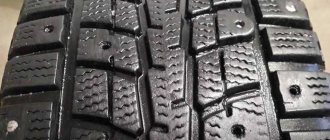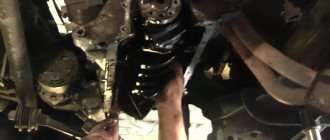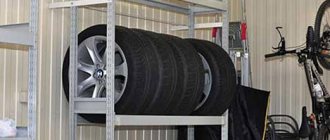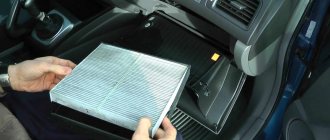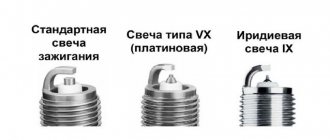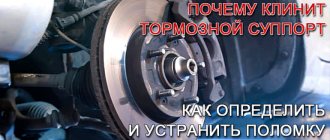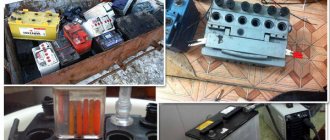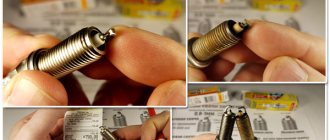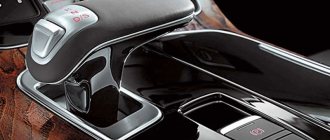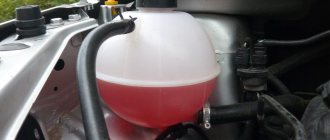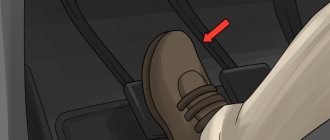Depth of recesses for valves, on the piston bottom. 2110, eliminates the possibility of valves coming into contact with the piston if the timing belt breaks.
The piston design of the 2110 and all subsequent models uses a loose fit piston pin. The clearance in the hole in the connecting rod head and in the holes in the piston ensures free rotation of the pin. The pin is secured in the axial direction with locking rings. For this purpose, the piston, in the pin holes, has installation grooves for retaining rings. On the outside of the piston pin holes, in the upper part, there are small recesses that make it easier to install and remove the circlips. In addition, they facilitate the access of oil to the contact area.
This design simplifies the assembly process and ensures uniform wear of rubbing surfaces, increasing the service life of parts. The piston diameter classes and piston pin hole classes adopted for model 21083 correspond to the classes of models 2110, 2112, 21124.
Basic casting markings applied to the part.
1. Product model designation – symbols “21” and “10”, in the area of the finger hole.
2. Designation, on the inside of the skirt.
3. Designation of casting equipment - letters and numbers, on the inside of the skirt.
4. The designation of the casting alloy is “AL34”, on the inside of the skirt.
Basic markings applied to the bottom.
1. Orientation marker – “ ” when installed, should indicate the direction towards the camshaft drive
2. Class marker - one of the symbols (“A”, “B”, “C”, “D”, “E”) determines the deviation in the outer diameter.
3. Piston mass group marker:
“ ” – normal;
“+” – increased by 5 g.
“ – ” – reduced by 5 g.
4. Piston pin hole class marker – one of the numbers (“1”, “2”, “3”) determines the deviation in the diameter of the piston pin hole.
The hole class marking is additionally applied with paint on the inside of the bottom:
blue color – 1st class
green color – 2nd grade
red – 3rd grade
Additionally, for repair pistons.
5. Marker for repair products:
“ ” – 1st repair (diameter increased by 0.4 mm from the nominal size.)
“ ” – 2nd repair (diameter increased by 0.8 mm from the nominal size.)
| PISTON | 21083-1004015 |
| Manufacturer | JSC AVTOVAZ |
| Piston diameter (nominal), mm: | 82,0 |
| Piston diameter (1st repair), mm: | 82,4 |
| Piston diameter (2nd repair), mm: | 82,8 |
| Weight, g: | 335,0 |
| Piston pin | 21213-1004020 |
| Piston pin diameter, mm: | 22 |
| Piston rings | 21083-1000100 |
| Ring height, mm: | 1,5/2,0/3,95 |
The depth of the recesses for the valves, on the bottom of the piston 21083, eliminates the possibility of the valves coming into contact with the piston if the timing belt breaks.
A design feature of the VAZ 21083 piston, which distinguishes it from the 2110 piston, is the method of fixing the piston pin. In the 21083 design, the piston pin (21213-1004020 or 2101-1004020) is pressed into the upper head of the connecting rod 2108-1004045. The tight fit defines the position of the finger and prevents it from moving. The diameter of the holes in the piston bosses provides the piston pin and connecting rod with free angular rotation. On the side surface, on the area near the hole for the piston pin, there are model markings - “21” and “083”. In terms of geometric parameters, there are no differences between the pistons of the VAZ 21083 and VAZ 2110 models.
Main Dimensions
| Piston class by outer diameter | A | B | C | D | E |
| Piston diameter 82.0 (mm) | 81,965-81,975 | 81,975-81,985 | 81,985-81,995 | 81,995-82,005 | 82,005-82,015 |
| Piston diameter 82.4 (mm) | 82,365-82,375 | 82,375-82,385 | 82,385-82,395 | 82,395-82,405 | 82,405-82,415 |
| Piston diameter 82.8 (mm) | 82,765-82,775 | 82,775-82,785 | 82,785-82,795 | 82,795-82,805 | 82,805-82,815 |
| Piston pin hole class | 1 | 2 | 3 |
| Piston pin hole diameter(mm) | 21,982-21,986 | 21,986-21,990 | 21,990-21,994 |
Applicability of piston 21083-1004015.
Diagram of the VAZ 21099 piston group: 1 - connecting rod bolt nut, 2 - connecting rod bearings, 3 - connecting rod, 4 - piston pin, 5 - upper compression ring groove, 6 - lower compression ring groove, 7 - oil scraper ring groove, 8 - piston, 9 — connecting rod bolt, 10 — connecting rod cover
For the convenience of selecting pistons for cylinders, cylinders and pistons, depending on the diameter, are divided into five size groups: A, B, C, D, E.
Pistons of nominal sizes of three classes are supplied as spare parts: A, C, E and two repair sizes. The first repair size is increased by 0.4 mm, the second - by 0.8 mm.
How to understand when it's time to change piston rings
When the car's oil consumption increased significantly, compression in the cylinders dropped. Before quickly rushing to the garage, you need to measure the compression, first on dry cylinders and then fill the cap from a bottle of oil and measure again and compare the results. If dry cylinder performance is lower, the piston rings must be replaced.
If not, then the rings have nothing to do with it, and you should pay attention to the caps and valves. Also, if low-grade oil is used, the piston rings may become stuck. This phenomenon usually occurs in cars whose engines have not been used for a long time, or have been used for very short distances.
Repair of central piston group
To replace the piston VAZ 21213 we need a pit or overpass and a standard set of tools.
Dismantling the cylinder head
So:
- The very first action at the beginning of each repair is to de-energize the vehicle's power supply system - remove the battery terminal;
- Drain all fluids from the lubrication system and cooling system;
- We remove all the “attached” equipment from the cylinder head: carburetor, ignition distributor with high-voltage wires, exhaust pipe, starter;
- Disconnect the wires from the oil and coolant temperature sensors;
- Remove the cylinder head cover;
- We unscrew the bolt securing the sprocket on the camshaft and remove it along with the chain;
Camshaft sprocket with chain
We take out the shaft along with the valve tappets and bearing housing;
Removing the camshaft
- We remove all hoses that will get in the way when dismantling the cylinder head;
- Using an extension and a socket, unscrew the block head and remove it.
Removing the block head
Removing the pallet
Begin:
- Remove the engine splash guard and the sump protection plate;
- On the side engine mounts, unscrew the nuts securing them to the cross beam brackets;
Unscrewing the gearbox bracket
- We disconnect the front axle gearbox and the engine bracket in order to raise the power unit;
- Raise the engine with a jack and insert wooden blocks between the supports and brackets of the transverse beam;
- Remove the jack from under the car;
- Using a ten-point socket, unscrew the twelve bolts securing the pan to the crankcase.
- Remove the oil pump intake filter.
- Next, unscrew the nuts of the lower connecting rod caps and remove them along with the liners.
Dismantling the connecting rod
Marking
How to choose a piston for engine 21083
Checking the condition of the pistons
We clean the piston from traces of carbon deposits and remove all deposits from the lubrication channels of the connecting rod and the piston itself
During inspection, we pay attention to characteristic cracks on the piston, its rings, pins, connecting rods and on the covers, which are a sign of maximum wear. Deep marks on the working surface of the liners also indicate that they should be replaced with new ones.
Selection of pistons for cylinders
The gap calculated for this pair, provided that they are new, is 0.025-0.045 mm. It is determined by measuring the elements of the piston group (cylinders and pistons) of the same class. For wear, the maximum tolerance is 0.15 mm. If the clearances are exceeded, it is necessary to select new pistons for the cylinders to achieve optimal values. Pistons of various classes (sizes) are supplied to the automotive spare parts market - A, C, E, which are quite enough to select pistons for any size of cylinders, since they, in turn, are also divided into classes that have a margin according to the limiting values of their dimensions. That is, a piston with class C is quite suitable for class B or D cylinders.
Disassembly
So:
- We remove the rings that lock the piston pin from the pistons, take it out and separate the connecting rod from the piston;
- Remove the piston rings.
Dimensions and markings of piston rings VAZ 2109 – 2115
I will now give you the main dimensions of the connecting rod and piston group below in the figure.
The piston is cast aluminum. According to the outer diameter, the pistons are divided into five classes (A, B, C, D, E) every 0.01 mm. The outer surface of the piston has a complex shape. Therefore, it is necessary to measure the piston diameter only in a plane perpendicular to the piston pin, at a distance of 55 mm from the piston bottom.
Main dimensions of the connecting rod VAZ 2109 – 2115
Based on the diameter of the hole for the piston pin, pistons are divided into three classes (1, 2, 3) every 0.004 mm.
The classes of piston diameters and holes for the piston pin are stamped on the bottom of the piston (Fig. 4).
The piston is cast aluminum. According to the outer diameter, the pistons are divided into five classes (A, B, C, D, E) every 0.01 mm. The outer surface of the piston has a complex shape. Therefore, it is necessary to measure the piston diameter only in a plane perpendicular to the piston pin, at a distance of 55 mm from the piston bottom.
Dimensions of piston rings VAZ 2109 – 2115
Based on the diameter of the hole for the piston pin, pistons are divided into three classes (1, 2, 3) every 0.004 mm.
The classes of piston diameters and piston pin holes are stamped on the piston crown.
Piston markings VAZ 2109 – 2115
Technical data
When boring the block and installing pistons into the cylinder block, it is necessary to follow the piston manufacturer's recommendations for machining cylinders, mounting and installing parts of the cylinder-piston group. The main information is printed on the top of the piston. If any information is not provided by the piston manufacturer, either on the packaging or on the piston itself, then the vehicle manufacturer's recommendations must be followed.
Piston size. Some piston manufacturers mark the size of the piston itself in hundredths of a millimeter on the piston bottom; this control parameter allows you to check the quality of the pistons and the dimensional accuracy before direct installation. For example: 83.93. This means that at the measured points the piston size does not exceed the specified size (taking into account the tolerance range). The measurement should be made at piston temperature (+20 degrees), using a micrometer or similar measuring instrument, with a measurement accuracy of one hundredth of a millimeter (0.01mm).
Installation gap. In order to ensure sealing of the working cavity of the cylinder and minimal friction work of the piston, as well as to prevent the hot piston from jamming, an installation (temperature) gap (Sp) is provided between the piston and the cylinder wall. With an increased gap between the piston and the cylinder wall, engine performance noticeably deteriorates - gases break through into the engine crankcase, the quality of the oil deteriorates because of this, the rings become coked and engine power decreases. The size of this gap is set by the piston manufacturer for the initial temperature of the parts of the cylinder-piston group (usually +20 degrees), and depends mainly on the temperature difference, the mass of the piston and the properties of the materials of the contacting parts. Example: Sp=0.04. This means that the gap between the piston (according to the maximum size of the piston skirt) and the cylinder should be 0.04 mm (taking into account the tolerance range).
Trademark. Every serious piston manufacturer labels its products with its own trademark. Firstly, this is part of the fight against counterfeit products, and secondly, having dismantled the old piston during repair, it immediately becomes possible to identify it using the casting number on the piston bottom.
Installation direction. The pistons of modern engines have a strictly defined position in the engine, in particular, this is due to the fact that the piston pin axis has some displacement relative to the central axis of symmetry of the piston. This was done to reduce noise during engine operation, or rather shock loads on the cylinder walls when the piston is moved to the extreme position. As a rule, manufacturers use two ways to depict the installation direction - (for engines located at the front and rear of the car). On the bottom there is either an arrow indicating the direction of the front of the car (direction of movement), or a crankshaft with a flywheel is schematically depicted.
Experienced motorists often encounter a difficulty in their work when a very old car comes in for repair, and there is no way to accurately identify the type of its engine. Often there is simply incorrect information in the documents for the car, for example, an error (typo) in the VIN code or in the “ENGINE TYPE” column. But it needs to be repaired, and it is necessary to choose the right repair pistons.
Then information about the casting number on the inside of the piston comes to the rescue. You should remove the piston from the cylinder block, clean the internal cavity of carbon deposits and read the cast numbers and letters. This method is not suitable for all pistons, but the main suppliers of European car conveyors MAHLE, Kolbenschmidt, AE, Nural allow you to decipher this data. What is a “casting number”? Pistons having the same basic parameters are manufactured on the same technological equipment (in particular, in the same injection mold), then subjected to subsequent mechanical processing depending on the required repair size and modification. That is, for pistons with STD and repair dimensions, the casting numbers are the same. As a rule, several pistons per engine correspond to one casting number; this is a standard piston and its subsequent repairs. But there are exceptions (when the casting number coincides with several modifications of the piston), then it is necessary to measure the controlled geometric parameters.
How to decrypt? We recommend checking your casting numbers through the paper catalogs of the relevant manufacturers. In addition, you can decrypt this data using the on-line catalogs of our suppliers.
You should determine the manufacturer of the old piston by trade marking, and then, using its catalog (paper or electronic), enter the found number. The value of the casting number must be entered directly into the search field by part article (Artikel #) or search by number replacement (Reference No:). Do not forget to check the results obtained for the main geometric dimensions with the old parts.
Article source: https://avtodvigateli.com/detali/razmery-porshnej.html
Table of nominal sizes of cylinders and pistons
| Nominal: |
| upper compression ring |
| lower compression ring |
| oil scraper ring |
| Maximum permissible clearance for all rings |
| Nominal |
| Maximum permissible |
By weight, pistons are sorted into three groups: normal, increased and decreased by 5 g. These groups correspond to markings on the bottom of the piston: “G”, “+” and “-”.
Malfunctions of the engine piston group
When the components of the piston group wear out, problems arise in the operation of the power unit:
- When the engine is running warm, blue smoke is observed from the exhaust pipe, indicating oil has entered the combustion chamber. The problem occurs when a layer of coke forms on the piston rings, which causes the elements to become stuck. An additional symptom of a breakdown is a decrease in the level of engine oil in the crankcase.
- The appearance of white smoke in the exhaust gases of heated diesel engines (at standard load and no traces of water in the fuel) indicates a decrease in compression due to wear or destruction of rings or liner walls. Simultaneously with the appearance of white smoke, a decrease in power and torque of the power plant is observed. To restore functionality, you need to dismantle the head and check the condition of the piston group elements.
- Difficulty starting the engine (regardless of the coolant temperature) with working fuel supply and air purification systems indicates an increase in the clearance in the piston group. As the gaps increase, dull knocks appear, heard along the entire length of the block.
- A knock (or ringing) coming from the top of the diesel block when changing speed indicates the appearance of gaps between the upper connecting rod bushing and the pin. Wear on the piston rings further enhances the noise effect.
Diagnostics of the condition and troubleshooting of piston parts
To preliminary check the condition of the piston group of a tractor diesel engine, it is necessary to drain the oil from the crankcase and then remove the lower pan.
Then the decorative protective cover of the gas distribution mechanism is removed and the roller with the valve drive cams is removed, under which the bolts securing the head to the cylinder block are located.
After removing the head, the mechanic assesses the condition of the part; if cracks are detected, the power unit is removed from the tractor and sent to a service center for major repairs.
To check the condition and measure the dimensions, it is necessary to dismantle the piston group. In the process of disassembling the engine, the oil pump with the fluid supply lines to the rubbing vapors is removed, and then the bolts securing the connecting rod caps are unscrewed. The pistons and connecting rods are removed from the liners through the top of the block.
What is the permissible thermal gap in the piston ring lock?
Checking the state of elements consists of the following steps:
- Determine the inner diameter of the liner in the area of maximum wear (closer to the top). The measurement is made in 2 planes - parallel to the crankshaft, and then parallel to the direction of swing of the connecting rod mechanism.
- Check the piston diameter near the skirt (perpendicular to the piston pin axis).
- Assess the wear of the grooves intended for installing the rings. The measurement is made with a feeler gauge after cleaning the grooves and installing new rings.
- The gap between the pin and the corresponding bushing in the connecting rod is no more than 0.06 mm; if the value increases, the parts must be replaced.
- The fingers are replaced when an oval section or tapered wear (more than 0.02 mm) is detected. Bending or twisting of the connecting rod is not allowed (0.08 and 0.12 mm, respectively).
Table of repair sizes of piston group D-240
The industry produces 3 size groups of piston for MTZ D-240:
| Group designation | Inner diameter of the sleeve (minimum), mm | Inner diameter of the sleeve (maximum), mm | Piston diameter measured along the skirt (minimum), mm | Piston diameter measured along the skirt (maximum), mm |
| M | 110 | 110,02 | 109,88 | 109,90 |
| WITH | 110,02 | 110,04 | 109,90 | 109,92 |
| B | 110,04 | 110,06 | 109,92 | 109,94 |
Installing a piston on MTZ 80
The parts differ in the diameter of the mating elements; the marking is applied to the upper part of the liner cup, which is not used when operating the diesel engine. Pistons are marked by applying the corresponding letter on the bottom. When carrying out major repairs of the power unit, the use of parts from different sets is prohibited.
Source
